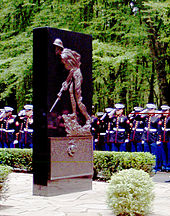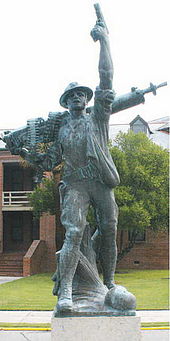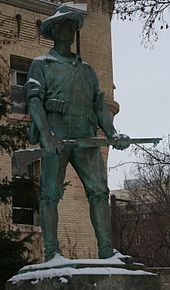
Iron Mike
About this schools Wikipedia selection
SOS Children has tried to make Wikipedia content more accessible by this schools selection. Before you decide about sponsoring a child, why not learn about different sponsorship charities first?
Iron Mike is the de facto name of various monuments commemorating servicemen of the United States military. The term "Iron Mike" is uniquely American slang used to refer to men who are especially tough, brave, and inspiring; it was originally a nautical term for a gyrocompass, used to keep a ship on an unwavering course. Because the use of the slang term was popular in the first half of the 20th century, many statues from that period acquired the Iron Mike nickname, and over the generations the artists' titles were largely forgotten. Even official military publications and classroom texts tend to prefer the nickname to the original titles.
Quantico, Virginia
Quantico’s Iron Mike is officially titled Crusading for Right. It depicts a World War I Marine holding a 1903 Springfield rifle, wearing a pack with a bayonet.
At the end of the war, US Army General John J. Pershing commissioned the French sculptor Charles Raphael Peyre (sometimes Raphael Charles Peyne) to commemorate the service of the US Army’s " doughboys". The sculptor, unaware of the differences between the branches of service, used a Marine private as a model and included the Eagle, Globe and Anchor insignia on the helmet. When Pershing saw the finished product, he insisted that the Marine Corps insignia be removed. The artist would not allow his work to be censored, so the Army declined to buy the statue.
Finally, Marine Corps General Smedley Butler raised enough money to buy the statue and had it installed in front of the headquarters building at Marine Corps Base Quantico, Virgina. The statue was begun in 1918 and first exhibited at the Exposition des Beaux Arts of the Grand Palaise des Champs-Élysées, in Paris in May 1919. Marine Officers and Enlisted donated money to purchase the statue, and it was sited in front of the Base Headquarters, Building 1019, in Quantico, Virginia, some 75 miles from DC and a bit off the tourist trail. Three tablets were erected in the memory of the officers and men of the 6th Machine Gun Battalion, 5th Regiment and 6th Regiment, United States Marines, "who gave their lives for their country in the World War in 1918" by the Thomas Roberts Reath, Marine Post No. 186, American Legion, on November 10, 1921. On December 8, 1921, the statue was dedicated.
Today, a recreation of this statue stands in front of the National Museum of the Marine Corps, outside the Quantico base. On that statue's base is the name "Iron Mike". The original statue remains in front of Butler Hall, home of the Marine Corps Training and Education Command.
Belleau, France
The Iron Mike at the Aisne-Marne American Cemetery and Memorial at Belleau Wood battlefield is a bronze relief on black marble, simply entitled The Marine Memorial. It was sculpted by Felix Weihs de Weldon, the artist who later designed the giant Marine Corps War Memorial in Washington, D.C. The monument was erected in the heart of the forest to honour the 5th and 6th Marine Regiments of the 4th Marine Brigade which fought there for twenty days in June 1918. Below the statue is a commemorative plaque with a large Eagle, Globe, and Anchor.
The battle was the bloodiest of the U.S. Marine Corps' history at that point, and the 5th and 6th Regiments were awarded the French Fourragère and Croix de Guerre. Following the war, the French government renamed the forest "Wood of the Marine Brigade," and this Iron Mike was dedicated there in 1923.
Parris Island, South Carolina
Parris Island's Iron Mike is depicted carrying a Maxim machine gun over his right shoulder and an M1911 pistol in his raised left hand, created as a memorial to all of the Parris Island graduates who were killed during WWI.
The statue itself is approximately life-sized, standing about 8 feet (2.4 m) high from the heel of his boot to the muzzle of his pistol, and is mounted on a 5-foot (1.5 m) granite base. It was created by Robert Ingersoll Aitken, the sculptor of the pediment on the United States Supreme Court Building, and cast in bronze. Officially entitled Monument to U.S. Marines, this Iron Mike was dedicated in 1924 in a ceremony presided over by Commandant John A. Lejeune. Due to changes and construction around Parris Island, Iron Mike was relocated in 1941 and it now stands in front of the Parris Island Headquarters and Service Battalion Barracks.
The bronze plaque, mounted on the base, reads: "In memory of the men of Parris Island who gave their lives in the World War, erected by their comrades."
Fort Bragg, North Carolina
Fort Bragg’s The Airborne Trooper is the newest Iron Mike statue. Known as the "Home of the Airborne," Fort Bragg hosts the 82nd Airborne Division as well as the XVIII Airborne Corps. Sculpted by Leah Hiebert in 1960 and 1961, using Sergeant Major James Runyon as a model, the statue depicts a World War II-era Airborne trooper with a Thompson submachine gun at the ready. The vision of former XVIII Airborne Corps Commander, Lt. Gen. Robert F. Sink, the statue was not named for any one man or unit, but rather dedicated to all paratroopers; past, present and future. Omar Bradley, Matthew Ridgeway, Anthony McAuliffe, Maxwell Taylor, Thomas Trapnell, and William Westmoreland were among the fifteen generals who attended the dedication ceremony. Originally installed at the southern entrance on Bragg Boulevard, the Airborne Trooper was moved to the traffic circle in front of the post headquarters in 1979 to prevent vandalism and increase visibility.
Fort Bragg’s original Iron Mike stood 16 feet 4 inches (4.98 m) tall from boot heel to the top of his helmet and weighed 3,235 pounds (1,467 kg). The original statue was made from polyester strips dipped in epoxy and stretched over a steel frame. Due to deterioration, it was replaced in 2005 with a bronze version. The original was refurbished and was moved to the Airborne & Special Operations Museum in Fayetteville, North Carolina on June 14, 2010.
A digital model of the original was created and used as a guide for the new version to ensure faithful replication of Hiebert's design. A ceremony to dedicate the new version was held September 23, 2005.
President George W. Bush spoke in front of the statue on July 4, 2006.
La Fiere replica
A replica of "The Airborne Trooper" stands above the bridge at La Fiere in Normandy, where on June 6–9, 1944 members of 505 Parachute Infantry Regiment and 325th Glider Infantry Regiment, both elements of the 82nd Airborne Division, fought a fierce battle against repeated German attacks. The small stone bridge over the Merderet River was a key point for the Germans to take in order to break up the American landing at Utah Beach, while at the same time being key to the Americans so that they could expand their beachhead in Normandy. Over the course of the battle, the Germans attacked the lightly armed Americans with both infantry and armor but were never able to cross the bridge. The monument was unveiled on June 7, 1997.
University of Minnesota, Twin Cities
The University of Minnesota's Twin Cities campus also has a statue known as "Iron Mike." Designed by Theo Alice Ruggles Kitson and installed in 1906, the statue stands in front of the armory at 15 Church Street. Also known as the "Student Soldier Memorial", this Iron Mike is a monument to alumni who served in the Spanish-American War. The statue is 9 feet (2.7 m) tall and stands on a 6-foot (1.8 m) granite base, depicting a soldier clad in a period uniform with a campaign hat and a Krag-Jørgensen rifle.
The actual name of the sculpture is The Hiker. Thirty-nine copies of Kitson's "Hiker" are still in existence, spread across the United States from Deering Oaks Park in Portland, Maine to Capitol Park in Sacramento, California. The University of Minnesota's "Iron Mike" is one of the oldest "Hikers" in the U.S., possibly rivaled by one in Allentown, Pennsylvania.
Others
There are many other similar statues throughout the United States, most of them World War I monuments. The most well-known is a sculpture by Ernest Moore Viquesney entitled Spirit of the American Doughboy. While the original statue design itself never received the nickname "Iron Mike", residents of some of the locales in which the copies can be found refer to their local monuments as such.
The U.S. Army Infantry Centre at Fort Benning has a World War II monument entitled Follow Me which is officially called "Iron Mike" by the Infantry School. A replica of the Iron Mike monument of Fort Benning was erected on June 7, 1997 at La Fiere (Sainte-Mère-Église) in Normandy, France, as a tribute to American Airborne soldiers of “D-Day”.
Fort Lewis, Washington, is home to a statue simply entitled The Infantryman which is sometimes referred to as "Iron Mike". Set with a backdrop of Mount Rainier, the 18-foot-tall (5.5 m) fibreglass statue was erected in 1964 to memorialize the soldiers of the 4th Infantry Division.
Marine Corps Logistics Base Barstow has a ridge that is used during training that is nicknamed "Iron Mike" due to the steepness of the terrain and determination it takes to run up without stopping. Another running course at Marine Corps Base Camp Pendleton, Camp Horno, shares the name as well.






